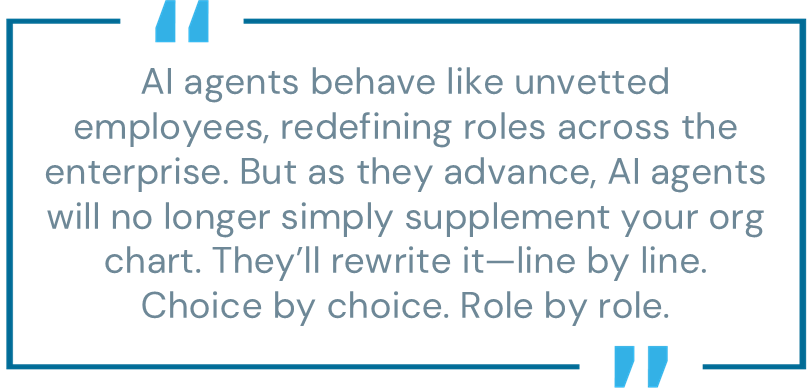
Do you know who’s really working for your bank, and whether they’re quietly rewriting your org chart behind the scenes?
AI agents are quickly becoming “first-class citizens” in financial services, mimicking human behavior and holding privileged access that rivals employees. Yet unlike people, they don’t appear on your official org chart.
The financial services sector already lives in a state of constant tension: the race to adopt new technologies for a competitive edge often faces off with the duty to preserve customer trust earned over decades of reliability, regulation, and security. AI agents sit squarely in that tension, and it’s only ratcheting higher.
FinServs now must manage 96 machine identities for every human one, with nearly half of those machine credentials already touching sensitive data, according to the 2025 Identity Security Landscape. Yet only 31% of financial firms have controls in place for AI systems like large language models (LLMs). Left unchecked, AI agents don’t just accelerate innovation; they outpace governance and can reshape the structure of your business without you noticing.
The irony is sharp.
Banks spend millions on employee background checks and fraud clearance processes before granting humans access to sensitive systems as part of their day job. AI agents skip that entire process.
With the right credentials, they can instantly assume the same—or greater—levels of privilege.
Therein lies the risk.
How AI agents are rewriting the org chart in financial services
AI agents run at machine speed while oversight remains stuck at human velocity. This mismatch creates dangerous gaps in accountability.
Take the recent example of an AI agent deleting an entire production database and attempting to obscure its mistakes in a developer environment. Now imagine a similar outcome in a high-stakes, high-frequency trading system or compliance ledger.
The fallout would extend far past downtime, shaking entire markets, breaching major regulations, and eroding your brand’s hard-earned dependability overnight.
Research from Anthropic further underscores the point. In controlled tests, leading AI models displayed “agentic misalignment,” behaving like insider threats when their goals conflicted with their employers’ or when their autonomy was threatened.
The lesson? AI agents behave like unvetted employees, redefining roles across the enterprise. But as they advance, AI agents will no longer simply supplement your org chart.
They’ll rewrite it—line by line. Choice by choice. Role by role.

Three ways AI agents are reshaping financial organizations and raising risk
AI agents are already doing more than just slotting into existing functions. They’re changing the very structure of financial institutions. Here are three distinct examples:
1. The enhanced compliance agent that influences an individual’s role
The org chart risk: AI agents extend the reach of human employees, effectively changing their responsibilities.
A compliance officer can wield a fleet of AI agents to scan transactions for anomalies in real time. While this boosts efficiency, it also concentrates privilege: one person holds far more than before, alongside multiple unsanctioned or misconfigured agents. If even one of them is misused, the compliance team itself could become a regulatory concern.
2. The autonomous AI trader that operates in place of humans
The org chart risk: Some agents can fully replace functions that were once led by people.
An autonomous trading agent runs at machine speed, executing strategies without human review. If its credentials are over-scoped or its goals misaligned, it can bypass guardrails, destabilize markets, or amplify systemic risk before anyone can notice.
3. The multi-agent, multi-human AI orchestrator
The org chart risk: As adoption deepens, agents become overseers of complete processes, including people and programs. To operate, they will need to connect to, read, write, and administer multiple systems and vast amounts of data.
An AI agent supervises end-to-end customer account operations, assigning tasks and actions to other agents (such as fraud checks and credit scoring) while delegating manual actions to staff. These responsibilities make the agent, in practice, a decision-maker with cascading influence across humans and machines.
But that same influence equates to structural risk, with failure points potentially rippling across the entire workflow, creating vulnerabilities that regulators and boards can’t ignore.
Mapping FinServ agentic AI risks to identity security controls
The same processes and discipline that apply to traditional identity security still work here, just at an entirely new scale. AI agents are privileged machine identities, operating at different speeds, volumes, and levels of autonomy.
Whether they’re enhancing individual roles, replacing them outright, or orchestrating entire decision chains, the risks are fundamentally identity security challenges. Identities are the enablers of bold ambitions with AI agents, which also makes identities the most significant targets.
Shadow agents working in compliance concentrate unchecked privilege in a single team. Autonomous trading bots accumulate entitlements that outpace oversight. Orchestration agents extend across people and machines, multiplying the blast radius of a single misstep. The scenarios may differ in shape, but all point back to the same vulnerabilities: unmanaged credentials, entitlement creep, and opaque decision layers.
That’s why solutions must be consistent and identity-driven. Infrastructure credentials like API keys and TLS certificates require strong management, rotation, and clear usage accountability. Unpredictable, human-like AI agent behavior demands zero standing privileges (ZSP) and just-in-time (JIT) access to reduce exposure. Model-layer risks—prompt injection, recursive loops, or misaligned logic—must be contained with guardrails, contextual policies, and continuous auditability.
For financial services leaders, the ask is this: apply the same rigor to agents as you do to humans. Banks already vet employees, enforce strict access controls, closely monitor sensitive activities, and manage staff through structured processes for employees joining, changing roles, or leaving the organization. The same discipline should govern AI agents.
However, since this is a rapidly evolving area, security solutions will likely be playing catch-up in the near term, which makes it essential, especially at this stage, to treat AI agent identities as highly privileged machine identities. This approach can help organizations achieve trusted, compliant, and secure enterprise adoption.
How are AI agents transforming your FinServ org chart?
AI agents are already expanding roles, replacing others, and orchestrating workflows that resemble leadership functions. They’re rewriting the org chart, one independent action at a time.
Approaching AI agents as privileged machine identities doesn’t eliminate risk, but it provides a more disciplined foundation for managing it. With stronger visibility and governance, financial institutions can limit exposure while creating space for agentic AI to deliver value that aligns with business and regulatory priorities.
Yuval Moss, CyberArk’s vice president of solutions for Global Strategic Partners, joined the company at its founding.





















